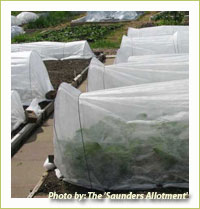Cold frames
Burpee Edible Gardening Team Members

*Sigh* We’re already missing the warm, sunny days of summer and the delight we had tending our vegetable garden. But even though most growing zones in North America have gone to sleep for the winter, you can still try your hand at cool season growing with the help of cloches.
Cloches are also known as hoophouses, cold frames, hot beds, or row covers. They’re mostly informal structures – sheets of plastic laid over hoops – but they can be built more elaborate with glass, aluminum, wood, and other sturdy materials.
They are a great ally to gardeners since they raise the temperature of the soil and air around plants. They also extend your gardening season, allowing you to plant a lot sooner in the springtime or well into winter.
For best results, your cloche should retain heat and transmit light (two important needs of successful vegetable plants). However, the structure should never be completely airtight, as lack of ventilation will encourage disease. Glass types are the best for keeping plants warm, and are a great transmitter of light. But they do get dirty quickly. Be sure to construct a glass cloche that’s easy to clean.
Plastic cloches and polyethylene sheeting structures can be moved around easier and can be shaped into various sizes to suit your needs and the needs of your growing plants. Hoop houses are simple to erect and transport, but be sure to replace the sheeting if it becomes yellow or torn.
Cold frames are like mini greenhouses! They are great for hardening off plants that were first raised indoors, and they retain heat well. They also stand up well against wind, since they’re constructed of very sturdy building materials. Poor ventilation is its vice, as well as a lack of portability.
All cloches should be anchored securely into the grounds for protection against weather and any highly-motivated animal visitors to your garden.
Some crops to consider for your cool season beds are Lettuce, Broccoli, Cauliflower, Cabbage and Peas. These varieties don’t mind a bit of cold, and some even taste better with a bit of frost! But with protective cloches, you can get a headstart on melons and herbs even in northern climates. For the southern growing zones, cloches offer the chance to garden year-round.
So, over the winter, get a cloche project on your to-do list and give it a try in early spring. Transform your garden into an all-season space for fresh vegetables and year-long enjoyment!
Photo credit: The 'Saunders Allotment'